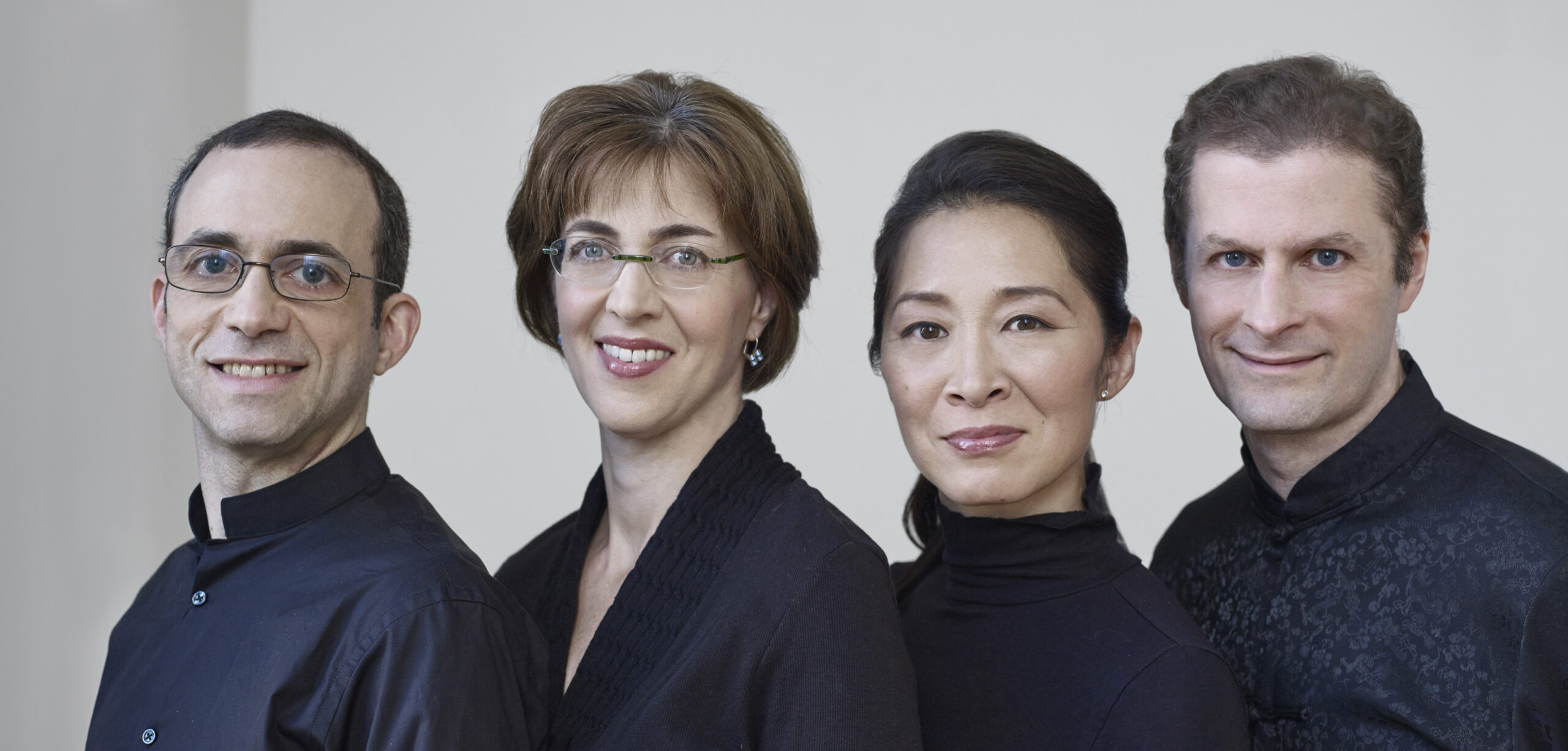Since its inception in 1992, the Brentano String Quartet has appeared throughout the world to popular and critical acclaim. “Passionate, uninhibited and spellbinding,” raves the London Independent; the New York Times extols its “luxuriously warm sound [and] yearning lyricism”; the Philadelphia Inquirer praises its “seemingly infallible instincts for finding the center of gravity in every phrase and musical gesture”; and the Times (London) opines, “the Brentanos are a magnificent string quartet…This was wonderful, selfless music-making.” The Quartet has performed across five continents in the world’s most prestigious venues, including Carnegie Hall in New York; the Library of Congress in Washington; the Concertgebouw in Amsterdam; the Konzerthaus in Vienna; Tokyo’s Suntory hall; and the Sydney Opera House. Festival appearances include Aspen, the Ojai Music Festival, the Edinburgh Festival, the Kuhmo Festival in Finland, and the Seoul Spring Festival of Chamber Music.
The Brentano Quartet will return for their 14th visit on our series, dating back to our 3rd season in 1995!
https://www.brentanoquartet.com/
The concert is followed by a reception where you can meet the artists.
All are encouraged to attend.
This concert is generously co-sponsored by Benjia Morgenstern
Franz Joseph Haydn (1732–1809)
String Quartet in B minor, Op. 33, No.1
Lei Liang (b. 1972)
Madrigal Mongolia (World Premiere)
L. van Beethoven (1770–1827)
String Quartet in Bb Major, Op. 18, No. 6
Program subject to change.
Franz Joseph Haydn
String Quartet in b minor, Op. 33 No.1
Allegro moderato
Scherzo: Allegro di molto
Andante
Finale: Presto
The Opus 33 “Russian Quartets” of Franz Joseph Haydn debuted in 1781, after a nine year hiatus from his previous beloved Opus 20 “Sun Quartets”, and was dedicated to Grand Duke Paul of Russia (who later became Czar Paul II). They are remarkable in their originality and deviation from any of his previous chamber music writing; Haydn himself described the set as being written “in an entirely new and original manner.” This set of quartets comes with a couple of different names besides the oft-used “Russian Quartets”; sometimes they are referred to as “Gli Scherzi,” for replacing the traditional Minuet movement with a faster, shorter Scherzo or Scherzando movement in each quartet in the set. One of the most distinctive attributes to this “new and original” style of writing was the sharing of musical ideas for all of the instruments, rather than having the first violin part be a soloistic part with the three others accompanying – instead this new way of writing gives way for the other instruments to carry important motifs and exchange, mimic or repeat lines between one another for a more equal and textural musical conversation. This thematic development is one of the most prominent characteristics of this set, along with his masterful weaving of the most clever and wittiest of musical lines for the string quartet. This “new style” would influence and impact string quartet and chamber music writing for the next 200 years.
In the Opus 33 No 1 quartet, the key of b minor is used, (the only one in the set that is in a minor key), which sets it apart in mood and character. The first movement, Allegro Moderato, opens with a D major chord and a mono-thematic motif but relatively quickly settles into b minor, with the motif being reworked in every way imaginable and passed down through each instrument in imitation or with a rhythmic reworking. The second movement, Scherzo: Allegro di molto, is a faster movement and employs “bariolage” bowing, whereby the player plays the same note on neighboring strings, a technique that is seen again in the last movement. There is a Trio section in B major that uplifts and invigorates the thematic material before moving into the third movement, Andante, which is the only movement in a major key and is filled with contemplative drama and chromaticism. The last Finale: Presto movement is fiery and fast, with more “bariolage” bowing technique being employed by the upper strings, with dynamic contrasts and chromatic runs creating drama and excitement to the very last chords.
Lei Liang
Madrigal Mongolia (World Premiere)
Madrigal Mongolia (for string quartet, 2024) sprang from a musical and spiritual heritage that has a special place in my heart – the music of Inner Mongolia.
I have loved this music since my childhood. One of my family’s closest friends, the renowned Mongolian scholar Wulalji visited our home in Beijing frequently. With a sip of alcohol, he would start singing, sometimes continuing late into the night. These personal memories date to the years after the Cultural Revolution, when obnoxiously cheerful propaganda music flooded the airwaves. Yet it was these lonely long songs that evoked in me a deep sense of longing and awakening.
The Mongols were the world’s most feared conquerors, yet the music they sing today is not martial in character. Quite the contrary, they sing of a mother’s devotion, friendship, loss of loved ones, and homeland. Their melancholy sentiments are understandable, for the warriors were always far from home. These songs remind us of what it means to be away.
Aren’t we all living far away from “home” today?
Madrigal Mongolia was commissioned by the Brentano Quartet who worked closely with Professor Chou Wen-chung who once told me these inspiring words about the cultural heritage of our home: “In calligraphy, every stroke has emotion. Here, lines become waves, and becomes textures.” Madrigal Mongolia was written in memory of him.
Madrigal Mongolia was commissioned by the Spiralis Music Trust in honor of Chou Wen-chung, ProtoStar Group, Salt Bay Chamberfest with Richard Replin, and Caramoor Center for Music and the Arts.
Ludwig van Beethoven
String Quartet in Bb Major, Op. 18 No. 6
Allegro con brio
Adagio ma non troppo
Scherzo: Allegro
La Malinconia: Adagio—Allegretto quasi Allegro
The Opus 18 quartets of Ludwig van Beethoven were commissioned by Prince Franz Joseph von Lobkowitz in 1795, however they weren’t finished until 1800, and published in 1801; the works were dedicated to Prince Lobkowitz. Beethoven reworked, reordered and revised many of the six quartets in the years that he composed them, sometimes working concurrently onwith several at a time and even reworking entire movements. Beethoven re-sorted the works when they were completed not by the order in which they were composed, but by their character; the Opus 18 quartets are known as his Early period; the first three are more traditional in style, whereas the latter three are somewhat more unorthodox and gives us glimmers of what’s to come in his Late period string quartets. The Opus 18 No. 6 quartet was written between 1798-1800, which was a transitional time between the Classical and Romantic eras, which by then had a well- established string quartet tradition by his predecessors Haydn and Mozart. It is clear to hear Beethoven’s homage to his predecessors in all the Opus 18 quartets in varying degrees, as Beethoven was greatly influenced by and studied Mozart and Haydn’s works, and even took lessons from Haydn for a time. After studying the genre, he started relatively late when he began writing string quartets, being almost 30 years old, although he was well-established as a composer of symphonies and other forms; he confessed to a friend to whom he had sent an earlier version of the Opus 18 quartet scores the following: “Be sure not to pass on your quartet to anyone else, because I have substantially altered it. For only now have I learned to write quartets properly – as you will surely see when you receive them.”
In the first movement, Allegro con brio, the opening melodic line exuberantly alternates between the first violin and cello, until the second violin takes on the role from the cello, and is boisterous and full of stark contrasts and dynamics. There is a remarkable, extensive transitional section in the development leading back to the recapitulation, culminating in a rambunctious run to the end of the movement. The second movement, Adagio ma non troppo is lush and glorious, with playful interplay between different instruments with a mellifluous and beautiful melody from the first violin. The third movement, Scherzo is an astonishing work of jilting syncopations and eccentric accents on offbeats, and extreme contrasts that could sit anywhere in Beethoven’s canon of sixteen string quartets and is very much a glimpse into the future. The last movement, La Malinconia: Adagio—Allegretto quasi Allegro Beethoven instructs the players “Questo pezzo si deve trattare colla più gran delicatezza” which means “This piece is to be played with the utmost delicacy.” It is another example of extreme contrasts and textures, of lightness and darkness, beseeching sinuous melodic lines punched with chords of suspense that eventually breaks into an amiable melody akin to a German dance. In the return of the melody of La Malinconia, we now hear it in a major key, which is then interrupted by slower darker Adagio measures and brighter Allegretto sections of the German dance melody contrasting with one another, until the last iteration of the dance melody bursts to the end in a joyful Prestissimo.
Brentano String Quartet
Mark Steinberg and Serena Canin, violins
Misha Amory, viola
Nina Lee, cello
Since its inception in 1992, the Brentano String Quartet has appeared throughout the world to popular and critical acclaim. “Passionate, uninhibited and spellbinding,” raves the London Independent; the New York Times extols its “luxuriously warm sound [and] yearning lyricism”; the Philadelphia Inquirer praises its “seemingly infallible instincts for finding the center of gravity in every phrase and musical gesture”; and the Times (London) opines, “the Brentanos are a magnificent string quartet…This was wonderful, selfless music-making.” The Quartet has performed across five continents in the world’s most prestigious venues, including Carnegie Hall in New York; the Library of Congress in Washington; the Concertgebouw in Amsterdam; the Konzerthaus in Vienna; Tokyo’s Suntory hall; and the Sydney Opera House. Festival appearances include Aspen, the Ojai Music Festival, the Edinburgh Festival, the Kuhmo Festival in Finland, and the Seoul Spring Festival of Chamber Music.
The Quartet has launched numerous projects that reimagine the standard concert program. In 2002, they celebrated their tenth anniversary by commissioning ten composers to write companion pieces for selections from Bach’s Art of Fugue, the result of which was an electrifying and wide-ranging single concert program. Fourteen years later, they revisited Bach’s masterpiece, performing the entire work in an ambitious multimedia project at the 92nd Street Y in New York with dancers, narrated excerpts, and an installation by artist Gabriel Calatrava. Recently, the Quartet presented a second multimedia project at the Y, which juxtaposed the poetry of Wallace Stevens with late Beethoven and music by composer Martin Bresnick. Other projects have included a three-program examination of Late Style, presented at Carnegie Hall; a program surveying the music of lamentation over the last 300 years crowned by Bartók’s Second Quartet; and numerous adaptations of music from Renaissance and early Baroque, including works by Josquin, Gesualdo, Purcell and Monteverdi.
The Quartet has been privileged to collaborate with such artists as soprano Jessye Norman, mezzo-soprano Joyce DiDonato, as well as pianists Jonathan Biss, Richard Goode and Mitsuko Uchida. The Quartet also maintains a strong commitment to new music, and has expanded the quartet canon by commissioning works from some of the most important composers of our time, among them Bruce Adolphe, Matthew Aucoin, Gabriela Frank, Stephen Hartke, Vijay Iyer, Steven Mackey, and Charles Wuorinen. Upcoming commissions and collaborations include a new quartet from Chinese composer Lei Liang; a viola quintet from James MacMillan; and a large-scale dramatic work, “Dido Reimagined,” based on the story of Dido and Aeneas, from composer Melinda Wagner and librettist Stephanie Fleischmann, to be performed with soprano Dawn Upshaw.
Dedicated and highly sought after as educators, the Quartet are currently Artists-in-Residence at the Yale School of Music, where they perform in concert each semester, work closely with students in chamber music contexts, and spearhead the instruction at the Norfolk Chamber Music Festival in the summers. The Quartet has given numerous master classes and workshops across the country, and returns annually to the Taos School of Music as visiting faculty. In 2013 and 2017, the Quartet assisted at the Cliburn International Piano Competition, performing quintets with competitors in the final rounds. Before coming to Yale, the Quartet served for fifteen years as Ensemble-in-Residence at Princeton University.
The Quartet has recorded extensively, releasing discs of quartets by Haydn, Mozart and Beethoven, as well as a recording of the Schubert Cello Quintet with Michael Kannen. The Quartet has also recorded music by several contemporary composers, among them Bruce Adolphe, Chou Wen-chung, Steven Mackey and Charles Wuorinen. The Quartet’s recording of Beethoven’s Quartet, Op. 131 was featured in the film “A Late Quartet,” starring Philip Seymour Hoffman and Christopher Walken, released in 2012. In 2017, they recorded a live album with Joyce DiDonato, “Into the Fire—Live from Wigmore Hall,” which included works by Strauss, Debussy, Guillaume Lekeu and Jake Heggie for Warner Classics. Their most recent release features the K. 428 and K. 465 (“Dissonance”) Quartets of Mozart for the Azica label.
Awards and honors include the first Cleveland Quartet Award (1995); the Naumburg Chamber Music Award (1995); inaugural members of Chamber Music Society Two at the CMS of Lincoln Center (1996); and the Royal Philharmonic Award for Most Outstanding Debut (at Wigmore Hall in 1997.)
The Quartet is named for Antonie Brentano, whom many scholars consider to be Beethoven’s “Immortal Beloved”, the intended recipient of his famous love confession.




